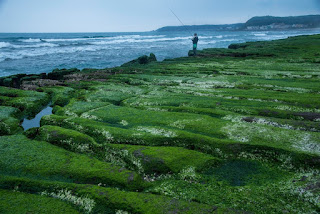Open Ocean Threats and Description Week 9
Open Ocean Description and Threats
Biome
The open ocean is a very unique biome. The open ocean is described as a dessert because there is little to no productivity. Even though the ocean takes up 71% of the earth the area per square foot is so low in productivity.
Photo from staticflickr.com
Sunlight and temperature are the two most important abiotic factors The temperature is constantly changing. When water is warmer it is less dense. When the water is cooler the water is more dense. The density of the water affects ocean and wind currents. When the sunlight hits the ocean only a little of it is affected by sunlight, this zone is called photiczone. This is where most aquatic organisms thrive. This is where the top primary producer, algae performs photosynthesis. Algae makes up to 70% of the oxygen in the atmosphere.
Photo from pexels.com
 This picture is a school of fish, herring to be exact. They swim in large numbers which makes it easier for consumption.
This picture is a school of fish, herring to be exact. They swim in large numbers which makes it easier for consumption.
Photo from flickr.com
Photo from Wikipedia.com
Threats
One of the most important threat to the open ocean is pollution of plastic which effect biotic and abiotic factors. There are many forms of pollution all humans induced. There are multiple giant garbage patches.
Photo from wikipedia.com
Photo from wikipedia.com
Another form of pollution is oil which is just as important as the pollution of plastic. Oil spills happen more often than not. Big oil companies such as British Petroleum are a contributing factor. Another human centric problem. Oil spills are accidents in the lack of safety regarding oil. Oil sticks to the fur, scales and shells of marine life. Marine life consume the oil through digestion or through their skin. When these organisms consume the oil it has an effect on their health and life span. If we then consume marine life that has had an exposure to oil we than have oil in our digestive systems.
Photo form wikipedia.com
People of Keene
The people of Keene, the students specifically because I am part of that community, consume plastic products every day, multiple times a day. Keene students litter all kinds of such as plastic bags, bottles, cans, cigarette butts and much more. Keene, NH is a college town.
Photo from flickr.com
Keene is known to be a party school which influences the lifestyle of the students and their litter. The students and people of Keene can start by banning plastic water bottles. There are numerous water filling stations around campus for reusable water bottles. Plastic bag ban has been issued in many cities around the US. If there were no plastic bag consumption in the town that would eliminate an unneeded litter of plastic.
Photo from wikipedia.com
The city of Keene has a massive waterway running through the town called the Ashuelot river. This river receives a lot of pollution from both the students and people of Keene. Run off of companies, house holds, people walking by. All this pollution eventually makes it way into the open ocean. Oil may be illegally dumped by business and households if the oil is old or no longer in use. Other run off from Keene could include chemicals and other substances that more or less have the same effect as oil. These substances will settle on the water beds floor and make its way into being consumed by organisms. Eventually leading into the oceans.
https://c1.staticflickr.com/5/4334/37001999386_153a6a5caf_b.jpg
https://www.pexels.com/photo/fisherman-green-reef-outdoor-wave-951255/
http://www.flickr.com/photos/jakecaptive/885981258/
https://en.wikipedia.org/wiki/Plankton
https://commons.wikimedia.org/wiki/File:Pacific-garbage-patch-map_2010_noaamdp.jpg
https://commons.wikimedia.org/wiki/File:Plastic_bag_jellyfish.JPG
https://commons.wikimedia.org/wiki/File:Deepwater_Horizon_Oil_Spill_-_Gulf_of_Mexico.jpg
https://www.flickr.com/photos/7726011@N07/18313563128
https://commons.wikimedia.org/wiki/File:Ashuelot_River_in_Keene_New_Hampshire_(5149313316).jpg
https://commons.wikimedia.org/wiki/File:Plastic_bag_jellyfish.JPG
https://commons.wikimedia.org/wiki/File:Deepwater_Horizon_Oil_Spill_-_Gulf_of_Mexico.jpg
https://www.flickr.com/photos/7726011@N07/18313563128
https://commons.wikimedia.org/wiki/File:Ashuelot_River_in_Keene_New_Hampshire_(5149313316).jpg








The part that resonates with me the most is the entire section about herring. It was very interesting as well as the ways Keene can help make campus a better place with less pollution. The thing that was the most new to me was that there are multiple giant garbage patches. I thought there was just one big one, which honestly doesn't make sense now, but the multiple makes more sense but is also very scary. The thing I noticed off the bat was how visually pleasing the layout is and I really like how the pictures are laid out. The only thing that I would suggest for next time is to just do a couple more read throughs so that the post is wiped of all grammatical errors.
ReplyDeleteThe part in this post that resonated the most with me was learning about the herring and how they need the warmer temperatures of water in order to reproduce and how the warmer water helps them be able to feed because zooplankton also thrive in warmer waters. The part that was most new to me was open ocean being called a desert because the productivity levels are so low. I liked how you expanded on that a few sentences more to compare the open ocean with the desert biome. I enjoyed the fact that you added a lot of pictures to your post. But, what I would suggest is that some of your paragraphs are only a few sentences with pictures in between while others are two paragraphs with a picture before and after. I think it would help your layout look more put together if you had added all the pictures after every paragraph if that was what you were looking to accomplish. Another suggestion would be to proof reread before posting and possibly change your wording of sentences around because in your second paragraph you have two sentences starting with “when the water is”.
ReplyDelete